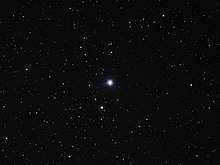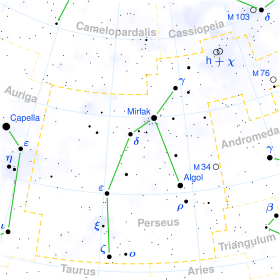Phi Persei
Phi Persei (Phi Per, φ Persei, φ Per) is a Class B2Vpe, fourth-magnitude star in the constellation Perseus. Phi Persei is binary consisting of a blue main sequence primary of class B2 and an apparent magnitude of 4.01 and a hot subdwarf secondary. Due to its rapid rotation, the primary has a polar radius about 5.5 R☉ and an equatorial radius of about 8.0 R☉. Phi Persei is also a variable star with rapid variations in its brightness and spectrum. The Phi Persei stellar system is located about 716 light-years from Earth.
| Observation data Epoch J2000 Equinox J2000 | |
|---|---|
| Constellation | Perseus |
| Right ascension | 01h 43m 39.63792s[1] |
| Declination | 50° 41′ 19.4328″[1] |
| Apparent magnitude (V) | 4.06[2] (3.96 - 4.11[3]) |
| Characteristics | |
| Spectral type | B2Vep[4] |
| U−B color index | -0.92[2] |
| B−V color index | -0.04[2] |
| Variable type | γ Cas[3] |
| Astrometry | |
| Radial velocity (Rv) | +0.80[5] km/s |
| Proper motion (μ) | RA: +24.59[1] mas/yr Dec.: -14.01[1] mas/yr |
| Parallax (π) | 4.54 ± 0.20[1] mas |
| Distance | 720 ± 30 ly (220 ± 10 pc) |
| Absolute magnitude (MV) | −3.11[6] |
| Orbit[6][7] | |
| Period (P) | 126.6731 days |
| Semi-major axis (a) | 5.89 mas |
| Inclination (i) | 77.6° |
| Longitude of the node (Ω) | 295.7° |
| Periastron epoch (T) | 2456110.03 |
| Semi-amplitude (K1) (primary) | 9.97 km/s |
| Semi-amplitude (K2) (secondary) | 81.3 km/s |
| Details | |
| A | |
| Mass | 10.1[8] M☉ |
| Radius | 5.5 - 8.0[6] R☉ |
| Luminosity | 41,783[9] L☉ |
| Surface gravity (log g) | 4.46[9] cgs |
| Temperature | 32,090[9] K |
| Rotational velocity (v sin i) | 440[9] km/s |
| B | |
| Mass | 1.14[10] M☉ |
| Radius | 1.3[10] R☉ |
| Surface gravity (log g) | 4.2[6] cgs |
| Temperature | 53,000[10] K |
| Age | 21.5[8] Myr |
| Other designations | |
| Database references | |
| SIMBAD | data |

Naming
Flamsteed followed Ptolemy in treating φ Persei as being in Andromeda and gave it the designation 54 Andromedae. It is isolated from the main stars of Perseus, but lies within its formal borders.[11]
In Chinese, 天大將軍 (Tiān Dà Jiāng Jūn), meaning Heaven's Great General, refers to an asterism consisting of φ Persei, γ Andromedae, 51 Andromedae, 49 Andromedae, χ Andromedae, υ Andromedae, τ Andromedae, 56 Andromedae, β Trianguli, γ Trianguli and δ Trianguli. Consequently, the Chinese name for φ Persei itself is 天大將軍二 (Tiān Dà Jiāng Jūn èr, English: the Second Star of Heaven's Great General.).[12]
References
- Van Leeuwen, F. (2007). "Validation of the new Hipparcos reduction". Astronomy and Astrophysics. 474 (2): 653–664. arXiv:0708.1752. Bibcode:2007A&A...474..653V. doi:10.1051/0004-6361:20078357. Vizier catalog entry
- Ducati, J. R. (2002). "VizieR Online Data Catalog: Catalogue of Stellar Photometry in Johnson's 11-color system". CDS/ADC Collection of Electronic Catalogues. 2237. Bibcode:2002yCat.2237....0D.
- Samus, N. N.; Durlevich, O. V.; et al. (2009). "VizieR Online Data Catalog: General Catalogue of Variable Stars (Samus+ 2007-2013)". VizieR On-line Data Catalog: B/GCVS. Originally Published in: 2009yCat....102025S. 1. Bibcode:2009yCat....1.2025S.
- Hoffleit, D.; Warren, W. H. (1995). "VizieR Online Data Catalog: Bright Star Catalogue, 5th Revised Ed. (Hoffleit+, 1991)". VizieR On-line Data Catalog: V/50. Originally Published in: 1964BS....C......0H. 5050. Bibcode:1995yCat.5050....0H.
- Wilson, R. E. (1953). "General Catalogue of Stellar Radial Velocities". Carnegie Institute Washington D.c. Publication. Carnegie Institution for Science. Bibcode:1953GCRV..C......0W. LCCN 54001336.
- Gies, Douglas R.; Bagnuolo, William G.; Ferrara, Elizabeth C.; Kaye, Anthony B.; Thaller, Michelle L.; Penny, Laura R.; Peters, Geraldine J. (1998). "Hubble Space Telescope Goddard High Resolution Spectrograph Observations of the Be + sdO Binary φ Persei". The Astrophysical Journal. 493 (1): 440–450. Bibcode:1998ApJ...493..440G. doi:10.1086/305113.
- "Sixth Catalog of Orbits of Visual Binary Stars". Retrieved 29 December 2016.
- Tetzlaff, N.; Neuhäuser, R.; Hohle, M. M. (2011). "A catalogue of young runaway Hipparcos stars within 3 kpc from the Sun". Monthly Notices of the Royal Astronomical Society. 410 (1): 190–200. arXiv:1007.4883. Bibcode:2011MNRAS.410..190T. doi:10.1111/j.1365-2966.2010.17434.x. Vizier catalog entry
- Zorec, J.; Frémat, Y.; Domiciano De Souza, A.; Royer, F.; Cidale, L.; Hubert, A.-M.; Semaan, T.; Martayan, C.; Cochetti, Y. R.; Arias, M. L.; Aidelman, Y.; Stee, P. (2017). "Critical study of the distribution of rotational velocities of Be stars". Astronomy & Astrophysics. 595: A132. arXiv:1702.07684. Bibcode:2016A&A...595A.132Z. doi:10.1051/0004-6361/201628760.
- Krtička, J.; Kubát, J.; Krtičková, I. (2016). "Stellar wind models of subluminous hot stars". Astronomy & Astrophysics. 593: A101. arXiv:1607.04445. Bibcode:2016A&A...593A.101K. doi:10.1051/0004-6361/201628433.
- Wagman, M. (August 1987). "Flamsteed's Missing Stars". Journal for the History of Astronomy. 18 (3): 212. Bibcode:1987JHA....18..209W. doi:10.1177/002182868701800305.
- (in Chinese) AEEA (Activities of Exhibition and Education in Astronomy) 天文教育資訊網 2006 年 7 月 10 日
